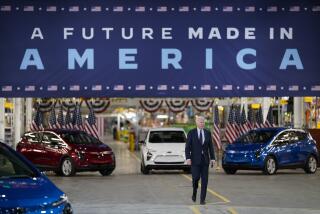Nationalize GM
- Share via
At the moment, D.C. and Detroit are brooding on a Morton’s Fork: Watch the American automakers auger in and take hundreds of thousands of jobs with them, or bail out these failed and incorrigible companies whose management so richly deserves whatever hell (flying coach?) awaits them.
Tops on the critics’ list of grievances is Detroit’s failure to anticipate the inevitable. Why didn’t these companies sufficiently invest in next-generation technology -- fuel-efficient small cars, high-mileage hybrids, plug-ins and all-electric vehicles -- that could help wean the U.S. off foreign oil and take the automobile out of the climate-change equation? As the auto executives again bring their begging bowl to Congress, a consensus is forming: No bailout unless Detroit builds greener cars.
From my perch, as someone who drives all of the Big Three’s North American product offerings, I think a lot of the anger is reflexive and misplaced. Detroit makes some amazing cars, and anyone who thinks otherwise should hold a Corvette ZR1 to his head and pull the trigger. The Ford F-150 pickup I drove last week flat-out humbles rivals from Toyota or Nissan. Considering that the domestic carmakers are shouldering titanic “legacy” costs -- it’s estimated that $2,000 in healthcare, pension and employee post-retirement benefits are baked into the price of every UAW-built vehicle -- just being competitive in any segment is a signal achievement.
Nonetheless, the question remains: What to do about the domestic automakers? My modest proposal: Nationalize GM.
To be clear, I mean that the federal government should buy GM; forget rathole loans or nonvoting equity shares. The company’s stockholder value has been essentially wiped out. The company’s enterprise value -- the lock, stock and forklift price -- is about $32 billion; its total debt is $45 billion. Let’s make GM an offer.
If you feel the gall of free-market ideology rising, consider that the measures being bruited about as preconditions for a bailout -- firing GM’s top management; forcing a bankruptcy-like renegotiation of contracts with the UAW, suppliers and dealers (it has too many); and creating a czar of product development to force the building of green cars -- are nationalization in all but name. I say embrace it. GM-USA.
Here are the benefits of nationalization:
GM’s fundamental problem is that it’s too big -- and expecting it to fix itself in exchange for a $10-billion to $15-billion loan (its share of the vaunted $25-billion bailout) or magically right-size in Chapter 11 is foolhardy. It would take too long, cost too much and bankruptcy, should it come, would send customers running for the hills. Time is of the essence. Congress, writing a GM law and using federal power to abrogate contracts, could achieve at least some of these goals at a stroke.
GM is full of talent and potential. The company spent $8.1 billion on research and development last year, second only to Toyota. Of all the carmakers, GM is closest to commercializing a full-size, four-door, plug-in electric vehicle, the Volt, due in the fourth quarter of 2010. The Volt should travel about 40 miles in all-electric mode before requiring the services of its onboard, gas-powered generator. Many owners could go weeks before they used any gasoline. This is precisely the sort of car that environmental and energy security advocates have been clamoring for.
GM’s business is growing in other parts of the world; it’s only the North American operations that are killing the company. This is a corporation that had $181 billion in revenue and sold 9.4 million vehicles in 2007. To put it another way: GM, though distressed, looks like a good investment. Also, the federal government can sell the company -- at a profit -- once it’s righted and sailing forward again.
GM is competing with companies that are quasi-national now. If you consider the advantages the government of Japan has bestowed on Toyota, Nissan and Honda -- in terms of healthcare and retirement benefits for its employees -- the unevenness of the field is clear. The same goes for most European companies, and the rising rivals in China will enjoy similar state-subsidized advantages.
The government can afford long-term planning. Many of GM’s strategic missteps -- such as betting large on trucks and SUVs and not investing early in hybrid technology -- were the result of willful shortsightedness at the board level, responding to a financial market in which shareholders look for the quick return. Putting Uncle Sam in charge would fundamentally enlarge the return-on-investment horizon.
We need government-sized automotive help anyway. This country should be putting millions of plug-in hybrid and electric vehicles on the road. As far as I can tell, without big subsidies, there is no way in the near term to build these vehicles and make a reasonable profit, due to the stubbornly high cost of advanced batteries. Besides, if GM were owned by the government, it wouldn’t spend time and money litigating and lobbying against clean-air and safety rules
Why not pick up Ford and Chrysler too? If Chrysler goes south, it’s too small to drag down the rest of the domestic auto industry. Ford, which has been pursuing its “Way Forward” cost-cutting plan for more than two years, will probably survive the moment without government assistance, though it’s going to be close.
To be sure, the yard marks of democratic capitalism have moved under us in recent months. Last week, the feds announced that the government would take a $20-billion stake in Citigroup and guarantee hundreds of billions in risky assets, a move that would have seemed pure socialism had we not lived through the last few months. Have we not in effect nationalized the mortgage-loan industry?
I say, let’s avoid the euphemisms and have the courage of our supercharged Keynesian convictions. By nationalizing GM, we can aim the company’s astonishing resources at one of the biggest public-policy problems we have: oil. Restructured and refocused, GM could build green vehicles by the millions in a few years and still have the capacity to build gasoline- and diesel-powered pickups (which we’ll still need) ... and maybe even some Corvettes on the side.
Dan Neil is The Times’ automotive critic. dan.neil@latimes.com
More to Read
A cure for the common opinion
Get thought-provoking perspectives with our weekly newsletter.
You may occasionally receive promotional content from the Los Angeles Times.






